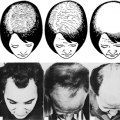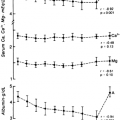BONE CHEMISTRY AND MINERALIZATION
Part of “CHAPTER 50 – PHYSIOLOGY OF BONE“
Bone mineral consists largely of hydroxyapatite [Ca10 (PO4) 6 (OH)2] together with transition forms and other minerals absorbed on the surface. The hydroxyapatite crystals are small and often have lattice defects, although these crystals become more complete as bone matures. The major absorbed minerals are carbonate, magnesium, and sodium. Ninety-nine percent of body calcium, 90% of phosphorus, 80% of carbonate, 80% of citrate, 60% of magnesium, and 35% of sodium are in the skeleton.
All these ions may be accessed when deficits exist and stored when excesses occur. Hydrogen ion is generated when hydroxyapatite is formed from circulating calcium and hydrogen phosphate. When a hydrogen ion excess occurs in the extracellular fluid, it can be buffered by demineralization, in which carbonate and phosphate are released from bone. Many bone-seeking elements exist, such as aluminum, fluoride, lead, and strontium. Deposition of these elements in the skeleton can prevent soft-tissue damage but is likely to alter bone cell function.
The organic matrix of bone is made up largely of type I collagen, which consists of tightly coiled, long, triple helical molecules containing two α1 chains and one α2 chain. The collagen molecules are strengthened by covalent intramolecular and intermolecular cross-links and are assembled in ordered fibers. The other collagen types, such as types III, IV, and V, are not deposited in the matrix but are present in interstitial and vascular structures. Type II collagen predominates in cartilage.
Stay updated, free articles. Join our Telegram channel

Full access? Get Clinical Tree





